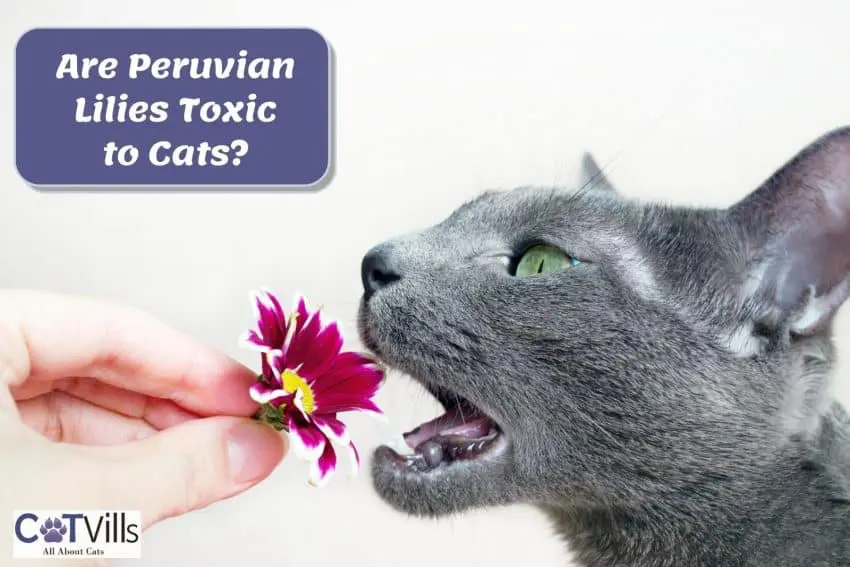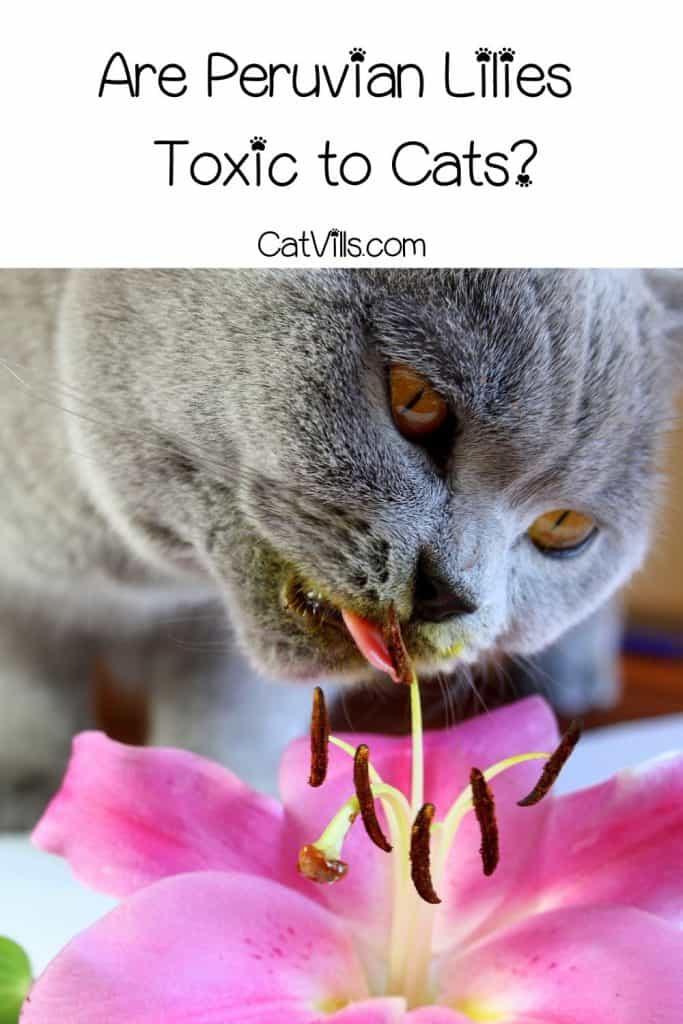Last Updated: 1 year ago
Are Peruvian lilies toxic to cats? That’s the question I’ll be exploring with you today in this article.
Your cat may be at one with nature; that doesn’t mean everything in nature is at one with her.
You may have heard talk of lilies being poisonous to cats, but is this true of all varieties of lilies, including the Peruvian lily?
Are Peruvian Lilies Toxic to Cats?

We’re not going to bury the lead on this one; if you arrived at this article via a Peruvian lily-induced Google search, you want answers.
Are Peruvian lilies poisonous to cats? No, they are non-toxic. Good news, right? People often refer to Alstroemeria as the Peruvian lily or the lily of the Incas.
They are not considered true lilies; they are simply called lilies because of their similar appearance. This is surprisingly common; many “lilies” are actually from a different family of plants altogether.
Enough with flower talk; you came here to read about cats eating flowers. I should definitely write about that.
So, what about the other types of lilies? Are they toxic to cats or not?
There’s one more thing to mention about Peruvian lilies. While they aren’t on any toxic flower lists, they can still cause some health issues for your cat.
Peruvian lilies contain the toxin Tulipalin A. Consuming a lot of this toxin could cause your cat to suffer from an upset stomach and vomiting.
Your cat would have to go to town on your Peruvian lily collection to suffer, and even then, the effects wouldn’t be life-threatening.
So, you don’t have to avoid the Peruvian lily altogether, but it may be worth keeping it out of your cat’s way.
8 Types of Lilies Poisonous to Cats

Lilies are popular with both florists and home gardeners. They’re pretty, colorful pants, so it’s easy to see the attraction.
As we learned above, there are lots of plants called lilies that aren’t actually part of the lily family. The true lily family are toxic to cats and are identifiable by their latin names (Lilium and Hemerocallis).
There are a wide variety of hybrid plants and many different species of lily, so it’s not practical for me to list them all here.
If you’re unsure whether a plant is toxic, the ASPCA has published a list of plants that are poisonous to cats.
Here are some of the most toxic lilies that you should avoid bringing into your homes, gardens, or sending to any cat-loving pet owner.
- Asian Lily (Lilium Asiatica): Also known as the Asiatic lily, this flower is highly poisonous to cats. They may look pretty, but you don’t want these anywhere near your feline friend.
- Daylily (Hemerocallis sp.): While it seems nobody can agree whether it’s spelled daylily or day lily, there is no debating the fact that these lilies are bad news for cats.
- Easter Lily (Lilium longiflorum): As the name would suggest, the Easter lily is traditionally associated with the celebration of Easter. Avoid bringing any into your home if you have cats, though, as they’re highly toxic.
- Japanese Show Lily (Lilium speciosum): The Japanese show lily is native to southern Japan and China but can be found worldwide. They should not find their way into your home as they are poisonous to cats.
- Stargazer Lily (Lilium ‘Stargazer’): Stargazer lilies get their name from the fact that they appear to look up to the sky. As with the other lilies on this list, they are toxic and dangerous for your cat.
- Tiger Lily (Lilium lancifolium or tigrinum): The vibrant orange petals with black spots leave us in no doubt about how the name Tiger lily came to be. Despite the feline name, they are not a suitable friend for your cat.
- Wood Lily (Lilium philadelphicum): The Wood lily goes by a few other names, including prairie lily and Philadelphia lily. They are native to North America and are, you guessed it, toxic to cats.
- Orienta Lily (Lilium orientalis): Oriental lilies can grow as tall as 6 feet. This doesn’t make them safe for cats; even a sip of the water from their pot could be fatal for your furry friend.
What Happens if a Cat Eats a Lily?

We’ve established that true lilies are dangerous flowers for your cat to be around. They are highly toxic, and eating even a small amount can prove to be fatal.
The FDA explains that lilies are so toxic, eating only a couple of leaves or petals can be lethal for a cat.
Even swallowing a few grains of pollen or sipping the water from the flower’s vase can cause kidney failure.
Studies show us that early symptoms and signs of lily poisoning include vomiting, drooling, loss of appetite, and depression.
The vomiting tends to stop after 4 to 6 hours which can be a false sign of recovery. It can cause owners and vets alike to assume the cat simply had a mild stomach upset.
The other symptoms will continue, and around 12 hours after the cat ate the plant matter, signs of kidney damage will start to appear.
Cats with reduced kidney function will become weak, dehydrated, and start vomiting again.
In as little as 3 days of the poisoning incident, affected cats can die of acute renal failure if they don’t receive immediate supportive care.
What to do if Your Cat Eats a Lily
Contact your vet immediately!
Early treatment is the key to a cat surviving lily poisoning. Get your cat to a veterinary clinic as soon as possible and identify the lily involved if possible.
In as little as 12 hours, your cat can suffer irreversible kidney damage.
Vomiting will help your cat get some of the toxins out of her system, and your vet may encourage her to bring more up.
IV fluids are likely to be given to help keep your cat hydrated and to prevent renal failure.
Activated charcoal is another treatment that is likely to be administered in an effort to limit the damage caused by the toxins.
FAQs
What happens if a cat eats Peruvian lilies?
The Peruvian lily is not listed as being toxic to cats. Unlike true lilies, eating a small amount of this flower will not result in acute kidney failure. However, eating a lot of Peruvian lilies could cause vomiting or diarrhea.
What is the most dangerous lily for cats?
While there are many plants with lily in their name, many are not true lilies. True lilies are all highly toxic to cats. They can be identified by their Latin name, which will contain either Lilium or Hemerocallis.
Conclusion
You came here asking, “Are Peruvian lilies toxic to cats?” You discovered that they aren’t actually true lilies and that they are not poisonous to cats.
We found that if your cat were to eat enough, it could still make her sick, but that it wouldn’t be life-threatening.
More importantly, we discussed how poisonous true lilies are to cats and the importance of avoiding the two ever being in the same space.
We saw reports of how quickly a cat’s kidney function can be affected by lily poisoning.
The key takeaway from this is to seek immediate veterinary treatment if you suspect your cat has eaten even a tiny amount of a true lily plant.
Are Peruvian lilies toxic to cats? No, they’re not! Do you know of any other things that are toxic to cats? Share below!

